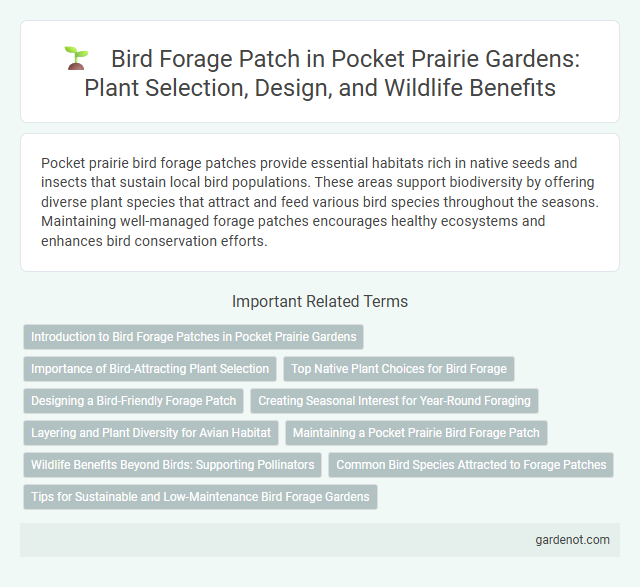Pocket prairie bird forage patches provide essential habitats rich in native seeds and insects that sustain local bird populations. These areas support biodiversity by offering diverse plant species that attract and feed various bird species throughout the seasons. Maintaining well-managed forage patches encourages healthy ecosystems and enhances bird conservation efforts.
Introduction to Bird Forage Patches in Pocket Prairie Gardens
Bird forage patches in pocket prairie gardens provide essential habitats for native bird species by offering diverse seeds, insects, and shelter throughout the seasons. These patches use native grasses, wildflowers, and shrubs that attract and sustain birds, enhancing local biodiversity and supporting ecosystem balance. Integrating bird forage patches promotes natural pest control and pollination, making pocket prairies valuable for wildlife conservation and garden health.
Importance of Bird-Attracting Plant Selection
Selecting bird-attracting plants in pocket prairies enhances biodiversity by providing essential foraging resources such as seeds, berries, and insects. Native species like coneflowers, sunflowers, and milkweed offer high nutritional value and habitat support for native bird populations. Thoughtful plant selection creates sustainable bird forage patches that improve ecosystem health and promote avian conservation.
Top Native Plant Choices for Bird Forage
Top native plants for bird forage in pocket prairies include coneflowers (Echinacea spp.), black-eyed Susans (Rudbeckia hirta), and goldenrods (Solidago spp.), which produce seeds and attract insects vital for bird diets. Native grasses like Little Bluestem (Schizachyrium scoparium) provide shelter and seed sources, while sunflowers (Helianthus spp.) offer high-energy seeds preferred by many bird species. Incorporating these plants enhances biodiversity and supports bird populations throughout seasonal changes.
Designing a Bird-Friendly Forage Patch
Designing a bird-friendly forage patch in a pocket prairie involves selecting native plants that provide abundant seeds, berries, and insects to support diverse bird species throughout the seasons. Incorporating varied heights and dense vegetation structure offers essential shelter and nesting opportunities, while ensuring continuous bloom periods maximizes food availability and habitat benefits. Integrating native grasses like little bluestem and wildflowers such as coneflower enhances ecological value and encourages local bird populations to thrive.
Creating Seasonal Interest for Year-Round Foraging
Bird forage patches in pocket prairies provide critical seasonal resources by incorporating diverse native plants that produce seeds, berries, and insects throughout the year. Selecting species such as purple coneflower, goldenrod, and serviceberry ensures continuous food availability and habitat variety. This strategic planting supports migratory and resident bird populations, enhancing biodiversity and ecological resilience.
Layering and Plant Diversity for Avian Habitat
A bird forage patch in a pocket prairie maximizes avian habitat quality through strategic layering and plant diversity, incorporating multiple vegetation strata from ground covers to shrubs. Diverse native grasses and flowering plants provide seeds, insects, and shelter, supporting various bird species' foraging needs year-round. This structural complexity enhances habitat resilience and encourages bird species richness, essential for ecosystem balance.
Maintaining a Pocket Prairie Bird Forage Patch
Maintaining a pocket prairie bird forage patch requires regular monitoring of native seed-producing plants such as coneflowers, goldenrods, and asters to ensure consistent food availability for local bird species. Periodic removal of invasive weeds and controlled mowing after seed set help preserve plant diversity and promote healthy seed regeneration. Providing layered vegetation structure with grasses like little bluestem and shrubs enhances shelter and foraging opportunities critical for sustaining bird populations year-round.
Wildlife Benefits Beyond Birds: Supporting Pollinators
Pocket prairie bird forage patches provide essential habitats that support a diverse range of pollinators including native bees, butterflies, and hummingbirds. These patches contain a variety of native flowering plants that produce nectar and pollen, promoting pollinator health and increasing biodiversity. Supporting pollinators enhances overall ecosystem stability by improving plant reproduction and fostering resilient wildlife populations.
Common Bird Species Attracted to Forage Patches
Bird forage patches within pocket prairies attract a diverse range of common bird species such as American Robins, Northern Cardinals, and Eastern Bluebirds, which rely on the abundant seeds and insects found in these habitats. These forage patches provide critical foraging opportunities during migration and breeding seasons, supporting bird populations by offering food sources like native grasses, wildflowers, and insect prey. Enhancing the diversity of native plants in pocket prairie forage patches significantly increases habitat suitability for insectivorous and granivorous bird species.
Tips for Sustainable and Low-Maintenance Bird Forage Gardens
Creating a sustainable bird forage patch involves planting native seed-bearing plants such as coneflowers, sunflowers, and asters that provide natural food sources for birds throughout the seasons. Incorporate diverse vegetation layers including shrubs and grasses to offer shelter and nesting spots, while minimizing the need for irrigation and fertilizers by selecting drought-resistant species. Regularly remove invasive plants and avoid chemical pesticides to maintain a healthy ecosystem that supports local bird populations year-round.
Bird forage patch Infographic

 gardenot.com
gardenot.com